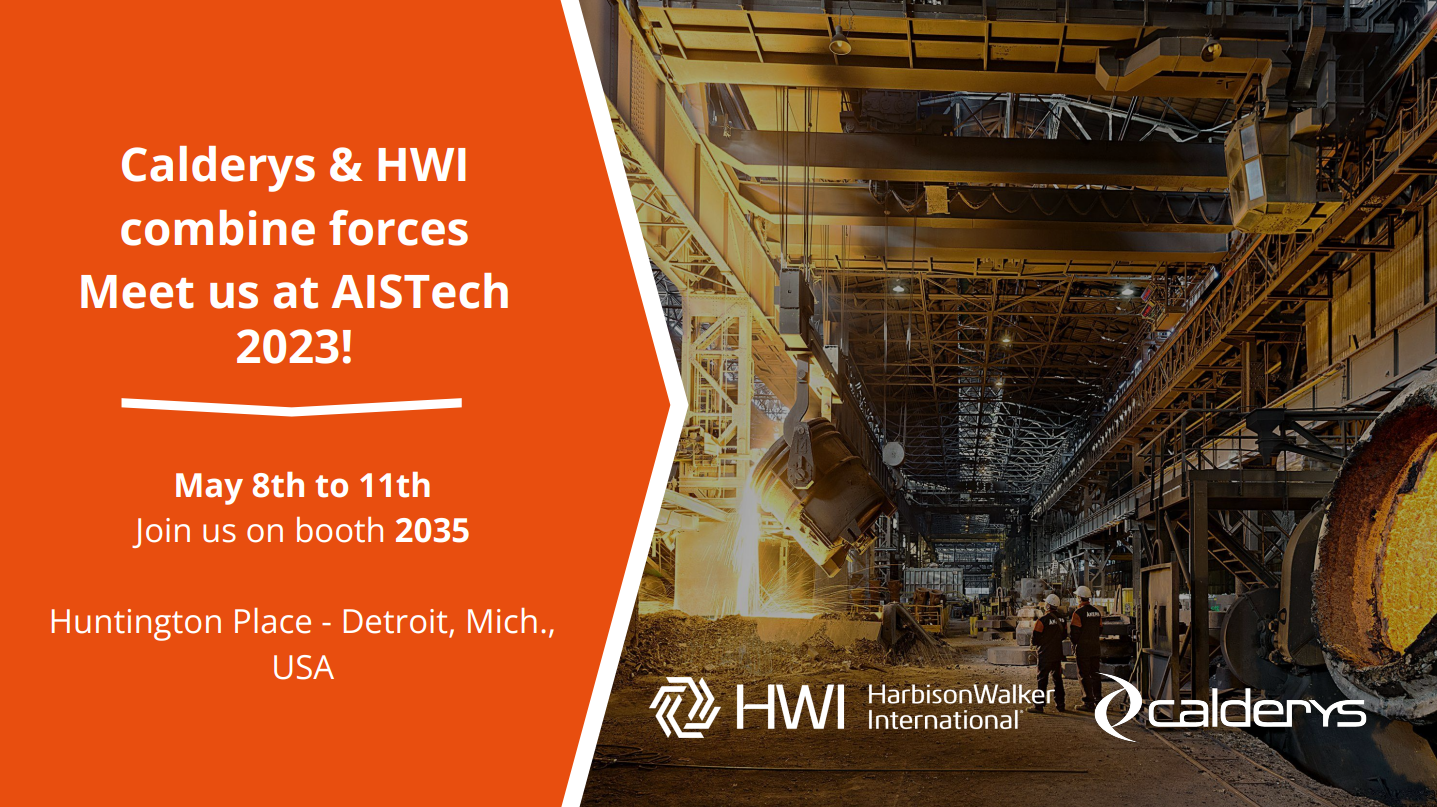8-11 May: Meet Calderys and HarbisonWalker International at AISTech!
Join us and discover our complementary and sustainable solutions!

We will be delighted to welcome you to our booth (2035) and let you discover our solutions related to refractories, steel casting fluxes, but also our automatic flux feeding equipment. Our experts will also speak at 5 technical sessions to present our cutting-edge expertise which meets our sustainable commitments and the needs of the steel industry:
Recycling of Refractory Within the Circular Economy
Authors: Sangram Mohapatra and Craigh Willoughby
Monday, May 8 4:30PM - 5:00PM
Responsible consumption and production is one of the seventeen sustainable development goals (SDGs) set up in 2015 by the United Nations General Assembly (UN-GA) and are intended to be achieved by 2030. This has triggered multitude of initiatives in the refractory industries, particularly designing refractory solutions in cooperation with clients prioritizing the use of recycled and reclaimed materials without compromising the expected performances. This methodology of incorporating a circular approach in refractory product developments is nascent and rapidly evolving, which not only reuses valuable minerals but reduces unnecessary landfill dumping. Present article describes Calderys’ approach towards circular design with an example of reclaimed materials that could be part of the solutions in bringing down the CO2 footprint.
Development of a Methodology for Life Cycle Assessment of Refractories and Fluxes Used in Iron and Steel Processes
Authors: Bruno Touzo, Emmanuelle Henry-Lannier and Laurence Canton
Monday, May 8 3:30PM - 4:00PM
Sustainability has become an integral part of products and processes. Refractories and other minerals used in the iron and steel manufacturing play an important role and need to bring their contribution to help reduce the environmental impact of the industry. A methodology was developed in Imerys and Calderys to assess the life cycle of their product, from cradle to gate. It is aligned with the WBCSD framework, consistent with ISO standards and used quantitative and qualitative indicators. This paper will present the methods, some results and how this can help Imerys and Calderys optimize new product and solution sustainability.
A Complete Refractory Solution for DRI Reactors With High Hydrogen Concentration in the Reducing Gas
Authors: Bruno Touzo, Sangram Mohapatra and Bertrand Hiot
Tuesday, May 9 2:00PM - 2:30PM
Direct reduction of iron technologies has proven to have lower CO2 footprint compared to the conventional blast furnace routes and are further moving towards higher hydrogen content in the reducing gas in order to minimize the direct CO2 emissions. High hydrogen concentration in the reducing gas may react with the refractory and change its texture, resulting in an alteration of chemical composition, thermal profile and affect the mechanical load bearing capacities of the refractory linings. This paper reviews the functional requirements of the refractory linings of a DRI reactor with higher percentage of H2 in the reducing gas and recommends optimum total solution, brick, monolithic and jointing products, based on the past experience and recent experimental studies.
Designing Mold Fluxes to Prevent Longitudinal Cracking for Peritectic Steel Slab Casting (more details to come)
Authors: José Augusto Cardoso Ferreira, Jeferson Klug and Edson Maranhão
Tuesday, May 9 3:00PM - 3:30PM
During continuous casting of hypo-peritectic steel slabs, control of horizontal heat transfer rate in mold is important to avoid longitudinal cracks. This rate can be manipulated by mold slag crystallization. From an industrial situation where the longitudinal cracking index was too high, a new mold flux was designed with appropriate crystallization kinetics. The mold flux crystallization process was analyzed in the laboratory through differential scanning calorimetry. The Friedman isoconversional method was applied to determine the activation energy of crystallization from melt. Besides, a new quick test was developed to evaluate crystallization kinetics. The industrial tests have shown that the new mold flux decreases the longitudinal cracking index, and this is related to the decrease of horizontal heat transfer rate during the continuous casting process, which in turn is related to crystallization from mold slag.
A Study on Carbon Pickup for ULC Steel Slab Casting (more details to come)
Authors: José Augusto Cardoso Ferreira, Jeferson Klug and Edson Maranhão
Tuesday, May 9 3:30PM - 4:00PM
Carbon pick-up for ultra-low carbon steel slabs is a major surface quality issue. It is important to study possibilities for reducing carbon content of mold flux, because its free carbon content can cause steel recarburization, even at low contents. A review was made considering studies for the replacement of carbon with nitrides and with exothermic agents. From this review, it became clear how exothermic materials can decrease the vertical heat flux, leading to a better thermal insulation of the steel; it is known that ULC steels form the hook more easily, and higher temperatures can minimize it. Besides, it became clear that it is very important to control the melting rate and the exothermicity when using exothermic agents; the lower the carbon content is, the higher the melting rate, and consequently the deeper is the slag pool. Some preliminary results of an research project under progress are shown; from melting rate qualitative measurements considering exothermic mold fluxes recipes, it was found that, for a base material with no carbon black added, but which still contain 0.5 wt% carbon due to addition of organic binder in the slurry used for the granulating process, the melting rate increases as the content of the exothermic materials increases.
About AISTech
AISTech is North America’s largest annual iron and steel technology conference and exposition. It provides a global perspective on today’s marketplace by featuring technologies from all over the world that help steelmakers to compete more effectively.
Every year, the steel industry’s premier technology event welcomes over 7,000 industry professionals from more than 40 countries: an audience representative of steel producers, suppliers, academia and students.
Watch our AISTech video: https://youtu.be/U8xlDZ4tZms
Find out more about AISTech: https://www.aist.org/conference-expositions/aistech

